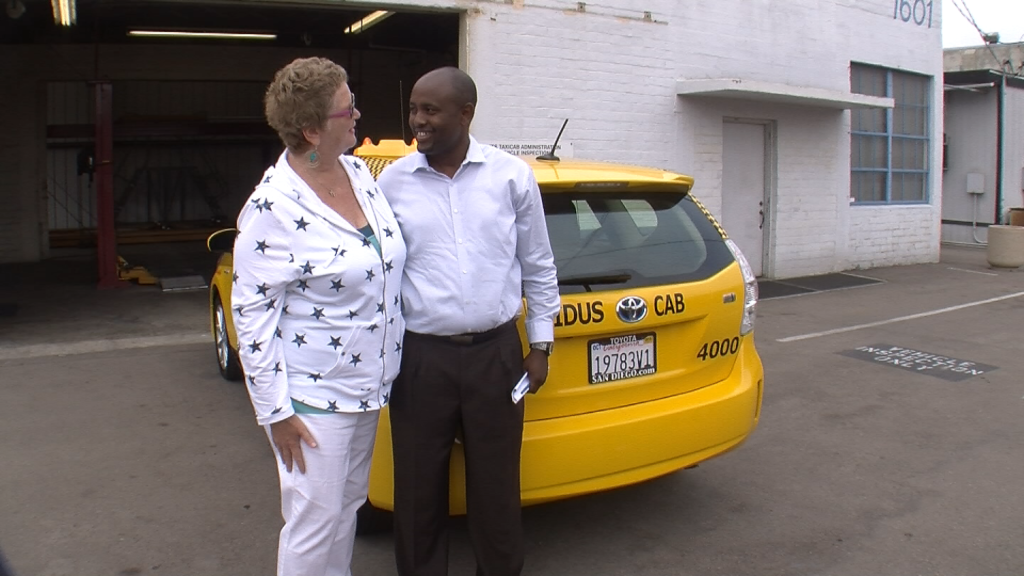 Cabdriver Adane Anjulo thanks San Diego Councilwoman Marti Emerald on July 14, 2015 for her work reforming the taxi industry. | Photo Credit: Megan Burks
Cabdriver Adane Anjulo thanks San Diego Councilwoman Marti Emerald on July 14, 2015 for her work reforming the taxi industry. | Photo Credit: Megan Burks
It’s been six months since San Diego began issuing new taxi permits and so far, it isn’t the deluge of new drivers critics forewarned.
After years of tense meetings, protests and a lawsuit, San Diego’s taxi market is open. The Metropolitan Transit System has put 141 new taxicabs in service since July. And nearly 500 drivers have initiated the months-long process, according to the transit agency.
It’s unclear how cabbies now stack up against Uber and Lyft drivers in the city. Both rideshare companies won’t say how many drivers they’ve added locally.
But Yellow Cab is on the offensive with a new mobile app called RideYellow. It was developed in San Diego and is rolling out across the country this month.
“Since (Councilwoman) Marti Emerald opened up the city, all cabs are looking for a competitive edge,” said Dan Brand, director of sales and marketing for Yellow Radio Service, which operates Yellow Cab and its dispatch centers.
Emerald represents District 9, where many immigrant cabdrivers live. She pushed to lift the cap on taxi permits in 2014, saying it might improve driver wages and force innovation in a new era for ride services.
“Uber is quoting that they have 11,000 drivers in San Diego alone, so it’s a difficult time,” Brand said.
Yellow Cab’s app uses the same kind of GPS technology as Lyft and Uber.
“But a different thing with our app is there’s no surge pricing. Whether it’s a busy weekend or New Year’s Eve, you’ll always pay just a flat $2 per mile,” Brand said. “And the drivers receive all the money that they make.”
Customers can also link a credit card to their account like the rideshare apps, or they can swipe their card in the vehicle or pay cash.
That kind of payment flexibility is actually required by the city. Local regulators also prohibit taxis from surcharging customers. And drivers do pay a flat fee to lease the car and work with Yellow Cab’s dispatchers.
The discrepancy between those entrenched local regulations and the state’s nascent rules for rideshares is why Yellow Cab joined a lawsuit against Uber last year. With the suit, cab companies tried to set themselves apart from Uber, saying they’re required to run more rigorous background checks for drivers and purchase more comprehensive insurance.
Uber, which has a $1 million policy like cabs but also relies on a driver’s personal insurancein some instances, has contested those claims.
Yellow Cab also joined other San Diego companies last year in legally challenging the city’s new open market policy. MTS and the city prevailed in that lawsuit in November.
If the challenge were upheld, it would have blocked efforts by United Taxi Workers of San Diego, which organized drivers behind the push for an open market. The drivers said they couldn’t make a living wage working as lease drivers with the larger taxi companies and wanted the chance to own and operate their cabs.
United Taxi Workers is starting its own dispatch service and ride-hailing app in the coming months. Its policy director, Sarah Saez, said many drivers interested in the city’s new permits are holding off until the United Taxi Workers services are up and running, meaning San Diego’s growing taxi industry could pick up speed later this year.
